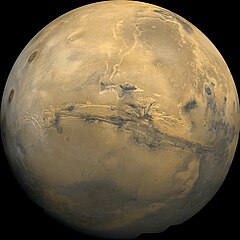Earth passes Mars every 780 days (or two years plus seven weeks and one day) at a distance of about 80,000,000 km. However, this varies because the orbits are elliptical. To a naked-eye observer, Mars usually shows a distinct yellow, orange or reddish colour, and varies in brightness more than any other planet as seen from Earth over the course of its orbit, due to the fact that when furthest away from the Earth it is more than seven times as far from the latter as when it is closest (and can be lost in the Sun's glare for months at a time when least favourably positioned). At its most favourable times — which occur twice every 32 years, alternately at 15 and 17-year intervals, and always between late July and late September — Mars shows a wealth of surface detail to a telescope. Especially noticeable, even at low magnification, are the polar ice caps.
The "Ares Vallis" area as photographed by Mars Pathfinder (click for detailed description).On August 27, 2003, at 9:51:13 UT, Mars made its closest approach to Earth in nearly 60,000 years: 55,758,006 km (approximately 35 million miles) without Light-time correction. This close approach came about because Mars was one day from opposition and about three days from its perihelion, making Mars particularly easy to see from Earth. The last time it came so close is estimated to have been on September 12, 57,617 BC. Detailed analysis of the solar system's gravitational landscape forecasts an even closer approach in 2287. However, to keep this in perspective, this record approach was only an imperceptibly tiny fraction less than other recent close approaches that occur four times every 284 years. For instance, the minimum distance on August 22, 1924 was 0.37284 AU, compared to 0.37271 AU on August 27, 2003, and the minimum distance on August 24, 2208 will be 0.37278 AU.
A transit of the Earth as seen from Mars will occur on November 10, 2084. At that time the Sun, the Earth and Mars will be exactly in a line. There are also transits of Mercury and transits of Venus, and the moon Deimos is of sufficiently small angular diameter that its partial "eclipses" of the Sun are best considered transits (see Transit of Deimos from Mars).
The only occultation of Mars by Venus to be observed was that of October 3, 1590, seen by M. Möstlin at Heidelberg
Dozens of spacecraft, including orbiters, landers, and rovers, have been sent to Mars by the Soviet Union, the United States, Europe, and Japan to study the planet's surface, climate, and geography. Roughly two-thirds of all spacecraft destined for Mars have failed in one manner or another before completing or even beginning their missions. Part of this high failure rate can be ascribed to technical problems, but enough have either failed or lost communications for no apparent reason that some researchers half-jokingly speak of an Earth-Mars "Bermuda Triangle" or of a Great Galactic Ghoul which subsists on a diet of Mars probes, or of a Mars Curse.
Among the most successful missions are the Mars probe program, the Mariner and Viking programs, Mars Global Surveyor, Mars Pathfinder, and Mars Odyssey. Global Surveyor has taken pictures of gullies and debris flow features that suggest there may be current sources of liquid water, similar to an aquifer, at or near the surface of the planet. Another possible origin proposed for these gully features is transient melting of surface water snow, frost, or ice. Mars Odyssey determined that there are significant deposits of water ice in the upper meter or so of Mars' regolith within 30° of the north and south pole.
In 2003, the ESA launched the Mars Express craft consisting of the Mars Express Orbiter and the lander Beagle 2. Attempts to contact the Beagle 2 failed and it was declared lost in early February 2004
Also in 2003, NASA launched the twin Mars Exploration Rovers named Spirit (MER-A) and Opportunity (MER-B). Both missions landed successfully in January 2004 and have met or exceeded all their targets; while a 90-day nominal mission was planned, as of December 2005, their missions have been extended twice and they continue to return science, although some mechanical faults have occurred. Among the most significant science return has been evidence of liquid water some time in the past at both landing sites. In addition, dust devils imaged from ground-level have been detected moving across the surface of Mars by Spirit (MER-A). Dust devils have even passed over the Rovers, cleaning the solar panels in the process (see picture below). Dust devils were first imaged on Mars from the surface by Mars Pathfinder.
Some evidence suggests that the planet once was significantly more habitable than today, but the question on whether living organisms ever actually existed there is an open one. Some researchers think that a certain rock which is believed to have originated on Mars - specifically, meteorite ALH84001 - does contain evidence of past biologic activity, but no consensus about these claims has been achieved so far and recent research indicates that the rock, since its creation several billion years ago, has never been exposed to temperatures for extended periods of time that would allow for liquid water.
The Viking probes carried experiments designed to detect microorganisms in Martian soil at their respective landing sites, and had some positive results, later denied by many scientists, resulting in ongoing controversy. Also, present biologic activity is one of the explanations that have been suggested for the presence of traces of methane within the Martian atmosphere, but other explanations not involving life are generally considered more likely.
If colonization is going to happen, Mars seems a likely choice due to its rather hospitable conditions (compared with other planets, it is most like Earth).








